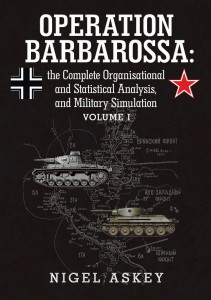A meeting with Colonel David Glantz (Rtd)
This past April, I had the distinct pleasure of spending an evening discussing history with Mr. Glantz. Mr. David Glantz has studied the Soviet military for over the last 40 years, initially studying the Soviet military as an adversary during the Cold War and subsequently, through his work as a historian. As an author of over 20 books, numerous articles, he has shared his knowledge of the Eastern Front with English readers, exploring this previously neglected field of history. His access to, and use of primary source material, in particular Russian source material not previously seen has presented the English reader with a new perspective from which to study the battles that raged on the Eastern Front.
Needless to say, I was excited to meet him, but in addition to the traditional historical discussions, I wanted to ask Mr. Glantz about his transition from military officer to historian. Currently serving in the military, I was keen to hear what advice he could provide to me?
We talked about the history of the Second World War. The amount of history, stories, and studies left to be discovered. We talked about how you can translate your experience in the military to the study of military history, using your knowledge of military documentation, units, and tactics to understand the documents written in the past. However, the most important thing I could do to study the history of the Eastern Front, would be to learn both Russian and German as this would allow me to read the original primary documents.
On the subject of reading, I love libraries and his study, with four walls with shelves from floor to ceiling filled with books, and a desk in the middle, was, from my perspective beautiful. His collection of books and primary documents, both in English, German, and Russian spanned unit histories, biographies, and after action studies and it is from this location, surrounded by information, that he writes each day.
As much as I wanted to learn about the transition from military officer to historian there were more than a few historical questions that I wanted to ask. One of the questions I asked Mr. Glantz was his opinion concerning the controversy as to whether or not the Soviets could have liberated Warsaw in August 1944 prior to the Germans destroying the city. One argument commonly made, states that the Soviet Army halted on purpose short of Warsaw, letting the Germans kill all the Polish rebels in the city. Another argument is that the Soviet Army at the end of Operation Bagration did not have the strength to overcome the German reserves thereby preventing the Soviet forces from reaching the city.
Mr. Glantz’s response to this question amazed me both for its clarity, and his documentation readily available with which he was able to substantiate his opinion. In his view, the Soviet Army was not in a position to liberate the city of Warsaw. Both because of the movement of German forces from Army Group South north, but also significant German anti-tank forces transferred to halt the Soviet advance. To illustrate the situation facing the Soviet forces, he pulled out the maps showing unit and formation locations from both the German, Soviet, and combined perspectives on a daily basis. The Soviet militaries inability to reach Warsaw did not mean that politics did not factor into the Soviet considerations as the Soviets refused to permit allied aircraft from landing in their territory. The restriction on western aircraft and by extension western aid was political, and this lack of aid accelerated the defeat of the Polish resistance. While militarily, the Soviets could not have intervened, they could have provided greater support to the resistance.
Politics and military action were intertwined throughout the Second World War, not only concerning Warsaw but also Berlin. We discussed the Vistula-Oder Offensive’s halt in February 1945. Mr. Glantz theorized that the reason for the halt of Soviet offensive was actually the Yalta conference, as the question of Austria whose occupation was not yet agreed upon. To ensure that Soviet forces were in possession of Austria when Germany surrendered, Zhukov’s forces were halted short of Berlin, and only upon seizure of Vienna was Berlin allowed to be seized. It was an interesting discussion that provided greater context to the books I have recently read concerning Operation Spring Awakening and the requirement to hold back by the 3rd Ukrainian Front for the subsequent attack to Vienna.
It was a pleasurable evening, and during the drive home, I reflected upon the topics we talked about, from the situation outside Warsaw, to the latest activities in the Crimea, and the changes in to access of the Russian achieves. I am very grateful to Mr. Glantz for the fact that he made time in his schedule to meet with me, to offer new insights and share his passion for history. The lasting effect of the evening is that I will be looking to learn Russian in the new year.
With sincere thanks,
-AR-
Image source: http://www.glantzbooks.com/

